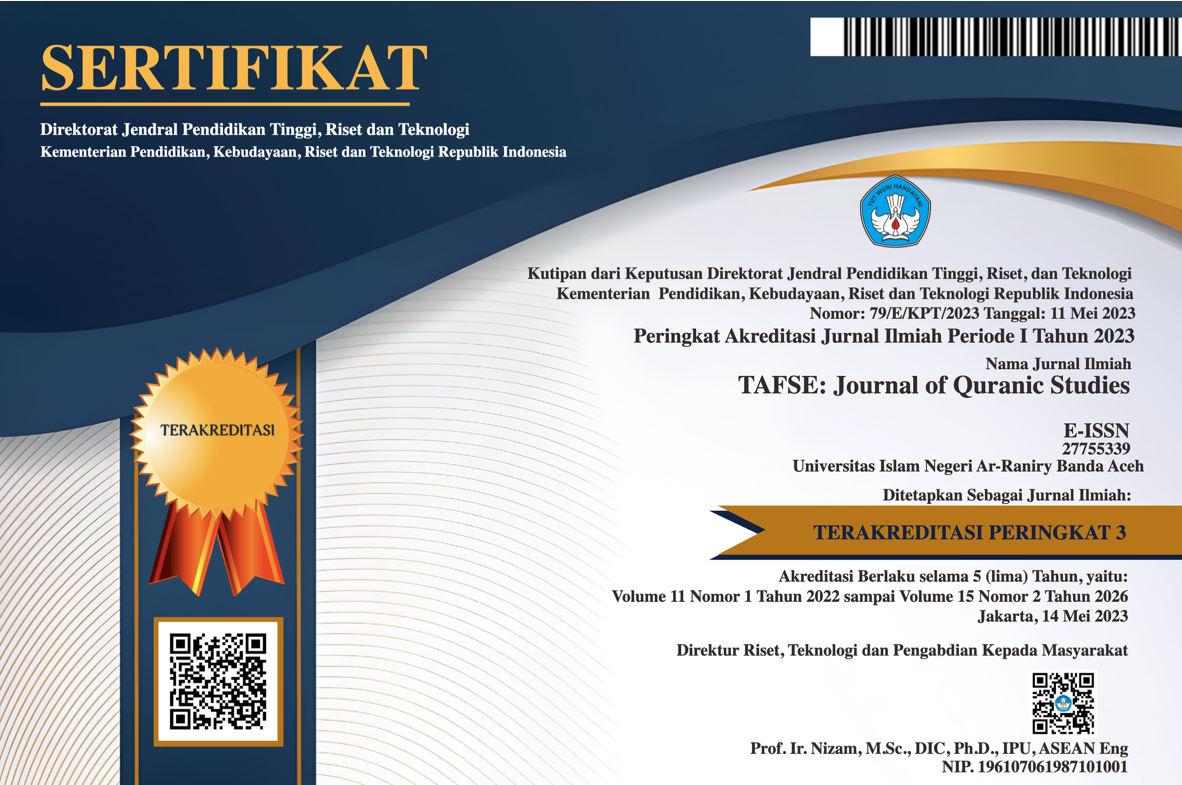Building a Harmonious Family in the Qur'an: An Analysis of Sternberg's Theory of Love on Household Harmony
DOI:
https://doi.org/10.22373/tafse.v9i1.21793Keywords:
Family, Harmony, Sternberg's Love TheoryAbstract
Family harmony is a fundamental human aspiration, significantly impacting the religious and educational development of children as they witness their parents' lives. This study explores the construction of a harmonious family according to the Qur'an, using Sternberg's love theory, which posits that an ideal marriage is built on three components: intimacy, passion, and commitment. Similarly, the Qur'an describes a harmonious family through the concepts of sakinah, mawaddah, and rahmah. This research is a library research study, utilizing data from various books and literature. The descriptive-analytical approach is employed to present and analyze the data in alignment with the Qur'an. The findings reveal that Sternberg's love theory aligns with the Qur'anic perspective on maintaining a healthy family sexual relationship, illustrated by the components of intimacy and passion, as reflected in the Qur'anic verses Al-Baqarah 2:223, An-Nisa' 4:19, and Al-Baqarah 2:187. These verses underscore the significance of sexual relations within the family. Additionally, the commitment component corresponds to the union of husband and wife in all matters, as depicted in An-Nisa' 4:1.
Downloads
References
Al-Ghzali, Abi Hamid Muhammad. Ihya’ Ulumuddin. Vol. 2. Beirut: Dar al-Ma’rifat, 2016.
Al-Hidayah. Al-Qur’an Terjemah Departemen Agama RI. Tanggerang Selatan: P.T. Kalim, n.d.
Bin Muhammad, Ahmad. Tafsir As-Shawi. Vol. 1. Beirut: Dar Al-Fikr, 2012.
Chadijah, Siti. ‘KARAKTERISTIK KELUARGA SAKINAH DALAM ISLAM’. Rausyan Fikr : Jurnal Pemikiran dan Pencerahan 14, no. 1 (5 March 2018). https://doi.org/10.31000/rf.v14i1.676.
Hariyanto, Erie, Abd Hannan, Arif Wahyudi, Eka Susylawati, and Bhismoadi Tri Wahyu Faizal. ‘Sakinah Family Empowerment by Optimizing the Role of BP4 and Parents Mental Revolution Perspective’. Samarah: Jurnal Hukum Keluarga Dan Hukum Islam 5, no. 2 (26 December 2021): 619. https://doi.org/10.22373/sjhk.v5i2.10965.
Goode, Wlliam J. Sosiologi Keluarga,. Jakarta: Bumi Aksara, 2004.
Hj Jaapar, Nur Zahidah, and Raihanah Azahari. ‘Model Keluarga Bahagia Menurut Islam’. Jurnal Fiqh 8, no. 1 (30 December 2011): 25–44. https://doi.org/10.22452/fiqh.vol8no1.2.
Ismatulloh, A M. ‘Konsep Sakinah, Mawaddah dan Rahmah dalam Al-Qur’an (Prespektif Penafsiran Kitab Al-Qur’an Dan Tafsirnya)’, n.d.
Khatimah, Umi Khusnul. ‘Hubungan Seksual Suami-Istri dalam Perspektif Gender dan Hukum Islam’. AHKAM : Jurnal Ilmu Syariah 13, no. 2 (7 August 2013). https://doi.org/10.15408/ajis.v13i2.936.
Kuswandi, Asih. Imu Kesejahteraan Keluarga. Semarang: UNNSPRESS, 2017.
Muhammad, Abu Jakfar. Tafsir At-Thabari. Beirut Lebanon: Dar Al-Ilmiah, 2009.
Muslim, Sri Banun. Supervisi Pendidikan Meningkatkan Kualitas Profesionalisme Guru. Mataram: Al-Fabeta, 2013.
Nasional, Depertemen Pendidikan. Kamus Besar Bahasa Indonesia. Jakarta: Balai Pustaka, 1976.
Nazaruddin, Nirwan. ‘Sakinah, Mawaddah Wa Rahmah sebagai Tujuan Pernikahan: Tinjauan Dalil dan Perbandingannya dengan Tujuan Lainnya Berdasarkan Hadits Shahih’. Jurnal Asy-Syukriyyah 21, no. 02 (16 October 2020): 164–74. https://doi.org/10.36769/asy.v21i02.110.
Ningrum, Amelia Pramesti Puspa, and Latif Nur Hasan. ‘Jenis Cinta dalam Antologi Cerkak Tabeting Lakon Kepungkur Karya Suryadi Ws’, 2023.
Qodratillah dkk, Meity Taqdir. Kamus Besar Bahasa Indonesia. Jakarta: Badan Pengembangan dan Pembinaan Bahasa Kementerian Pendidikan dan Kebudayaan, 2011.
Quthb, Sayyid. Tafsir Fi Dzilalil Qur’an. Vol. 1. Beirut: Dar As-Asyauq, 2004.
Sainul, Ahmad. ‘Konsep Keluarga Harmonis dalam Islam’ 4 (2018).
Sanu, Debora Kesia, and Joris Taneo. ‘Analisis Teori Cinta Sternberg dalam Keharmonisan Rumah Tangga’. JKKP (Jurnal Kesejahteraan Keluarga dan Pendidikan) 7, no. 02 (30 October 2020): 191–207. https://doi.org/10.21009/JKKP.072.07.
Shihab, Moh Quraish. Tafsir Al-Mishbāh: Pesan, Kesan, Dan Keserasian al-Qur’an. Cet. 6. Vol. 2. Ciputat, Jakarta: Lentera Hati, 2002.
Syah, Arif Sofian, and Suryo Ediyono. ‘Sudut Pandang Filsafat Cinta dan Psikologi Robert Sternberg’, n.d.
Warson, Munawwir. Kamus Al-Munawwir. Surabaya: Pustaka Progressif, 1997.
Yanti, Noffi. ‘Mewujudkan Keharmonisan Rumah Tangga Dengan Menggunakan Konseling Keluarga’. Al-Ittizaan: Jurnal Bimbingan Konseling Islam 3, no. 1 (25 April 2020): 8. https://doi.org/10.24014/0.8710152.
Wafa Alifatuzzahroh and Alfadhli Tasman, ‘Tawakal and Life Optimism for Divorced Married Couples: A Case Study in Medan, Satria Village, Bekasi City, West Java Province’, El-Usrah: Jurnal Hukum Keluarga 6, no. 2 (December 2023), http://dx.doi.org/10.22373/ujhk.v6i2.20000.
Yunistiati, Farida, M. As’ad Djalali, M. As’ad Djalali, M. As’ad Djalali, Muhammad Farid, Muhammad Farid, and Muhammad Farid. ‘Keharmonisan Keluarga, Konsep Diri dan Interaksi Sosial Remaja’. Persona:Jurnal Psikologi Indonesia 3, no. 01 (20 December 2014). https://doi.org/10.30996/persona.v3i01.371.
Zuhaili, Wahbah. Tafsir Al-Munir. Vol. 2. Beirut: Dar Al-Fikr, 2016.
Downloads
Published
Issue
Section
License
Authors who publish with this journal agree to the following terms:
- Authors retain copyright and grant the journal right of first publication with the work simultaneously licensed under a Creative Commons Attribution License (CC BY NC 4.0) that allows others to share the work with an acknowledgment of the work's authorship and initial publication in this journal.
- Authors are able to enter into separate, additional contractual arrangements for the non-exclusive distribution of the journal's published version of the work (e.g., post it to an institutional repository or publish it in a book), with an acknowledgment of its initial publication in this journal.
- Authors are permitted and encouraged to post their work online (e.g., in institutional repositories or on their website) prior to and during the submission process, as it can lead to productive exchanges, as well as earlier and greater citation of published work (See The Effect of Open Access).





